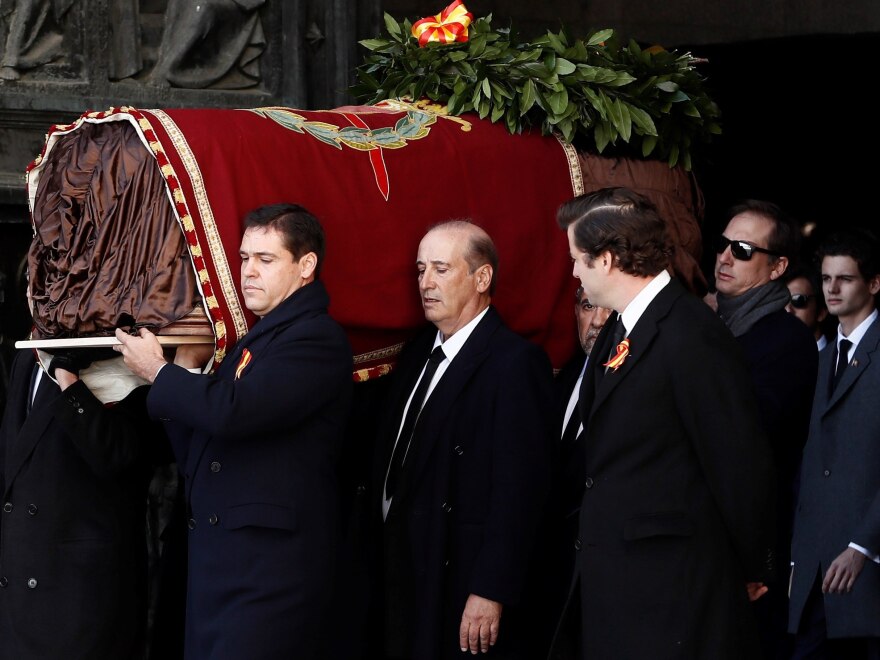The remains of Spanish dictator Gen. Francisco Franco have been exhumed, nearly four and a half decades after he was laid to rest in a colossal mausoleum in the Valley of the Fallen — the Valle de los Caídos — northwest of Madrid.
The removal of Franco, who rose to power in 80 years ago, got underway Thursday morning. After being extracted from the mausoleum, his remains were flown by helicopter to a more humble location — a family cemetery just north of Madrid where he was reburied next to his wife.
This appears to be the final chapter in an ongoing saga over exhuming the dictator's body. After months of appeals and legal proceedings, Spain's Supreme Court ruled unanimously last month that the country's caretaker government could go forward with moving Franco.

Getting the dictator's body out of the Valley of the Fallen, where he's been buried for the past 44 years, was central to a campaign promise by Spanish Prime Minister Pedro Sánchez. He was pressing for the process to be completed ahead of Spain's general elections next month.
On Thursday morning, vans began arriving at the tomb around 9:30 a.m. local time, Spanish newspaper El País reports. And just before noon, a 3,000-pound slab was reportedly hoisted off of the leader's coffin.
"At around 11.50 a.m., a slab of stone weighing 1.5 tons that covered the coffin was removed, said government sources, who declined to disclose where the tombstone will be stored from now on.
"At 12.40 p.m., the same sources reported that the coffin had been removed from its resting place. Around 10 minutes later, the coffin – covered by a dark brown shroud, a banner and adorned with a wreath and small Spanish flags – was carried out of the basilica by members of his family, down the stairs outside the place of worship and into a waiting funeral car."
In the 1930s, Franco led a military insurrection against the Second Spanish Republic that turned into a three-year civil war.
After the civil war ended in 1939, Franco became Spain's absolute ruler until his death in 1975. His burial in an elaborate tomb in Sierra de Guadarram — a spot that he chose, a little more than an hour northwest of Madrid — has led to decades of divisions and rancor in Spain.
Before it became Franco's semi-final resting place, the Valley of the Fallen was built as a mass grave for tens of thousands of people who died during Spain's civil war. Franco deemed it a healing tribute to the dead. But after he joined those buried there, critics called it an ornate homage to his time in power.
Franco's fascist government was notorious for imprisoning, torturing and killing people who spoke out against his regime. Last year, Spain's new Socialist-led government passed legislation that paved the way for the exhumation, And as NPR reported.
Critics have long argued that keeping Franco' remains at the mausoleum celebrates the leader's fascist regime. Those who wanted Franco to remain in the tomb say the media attention surrounding the exhumation would do nothing but dredge up pain and trauma that never fully healed once the war concluded.
VÍDEO | Concluye la protesta de un grupo de franquistas a las puertas de Mingorrubio https://t.co/82zs7elwLf pic.twitter.com/M4wMWomGjf
— eldiario.es (@eldiarioes) October 24, 2019
The Spanish government was also concerned that hundreds of protesters might shout insults at the prime minister as he arrived, according to the AP, which adds:
"Fearing disturbances, the government banned a demonstration against the exhumation by Franco supporters at the Mingorrubio cemetery although some 500 people waving Franco-era flags and symbols and changing 'Viva Franco' gathered near the cemetery as police looked on."
Present at the exhumation were other high-ranking Spanish officials as well as several of Franco's relatives, according to The Guardian:
"Twenty-two members of the Franco family gathered in the basilica, along with Spain's justice minister, Dolores Delgado, in her role as first notary of the kingdom.
"A canopy was erected to cover the grave and guard against any attempts to film the exhumation, and those present were checked for electronic devices to make sure there were no images or sound recordings."
In a video posted to the official twitter account of Prime Minister Sánchez, he heralded Franco's removal from the national park as "a tribute to all victims of hate."
"The Spain of today is a complete opposite of the one the Franco regime represented," Sánchez said. "When the Valley reopens it doors, those who arrive will find a different place, a tribute to all the victims of hate where those painful memories should never be repeated."
Copyright 2021 NPR. To see more, visit https://www.npr.org. 9(MDIwMjIxMDA0MDE0Mzk4NDIzNjA0OGQ5Yg001))
La España de hoy es el país más opuesto a lo que representó el régimen franquista. Cuando el Valle vuelva a abrir sus puertas, quienes accedan encontrarán un lugar distinto, el recuerdo de un dolor que no debe volver a repetirse jamás y un homenaje a todas las víctimas del odio. pic.twitter.com/kjWLCskuKt
— Pedro Sánchez (@sanchezcastejon) October 24, 2019



